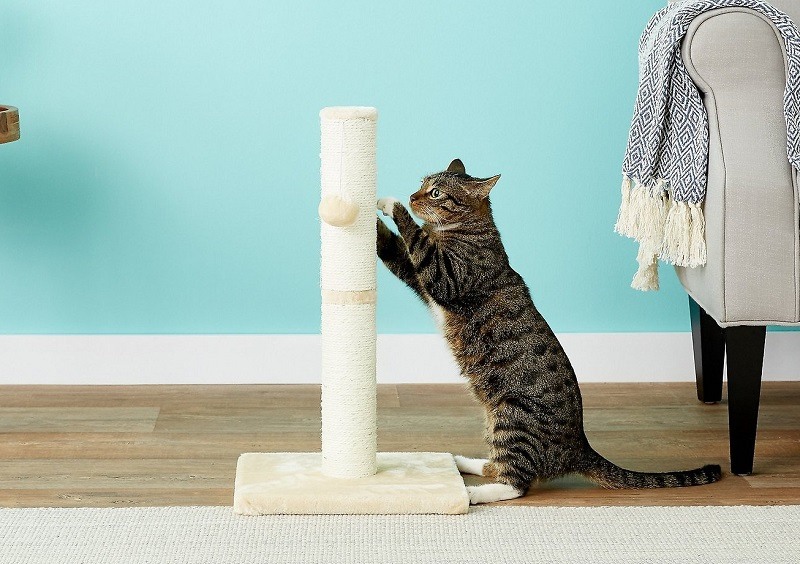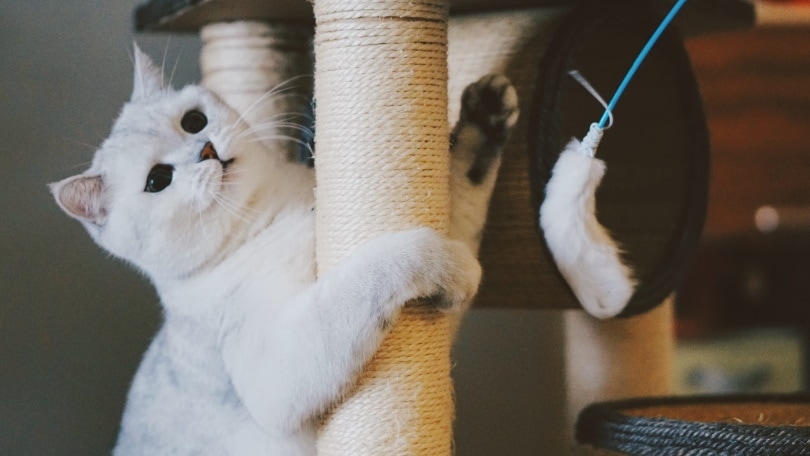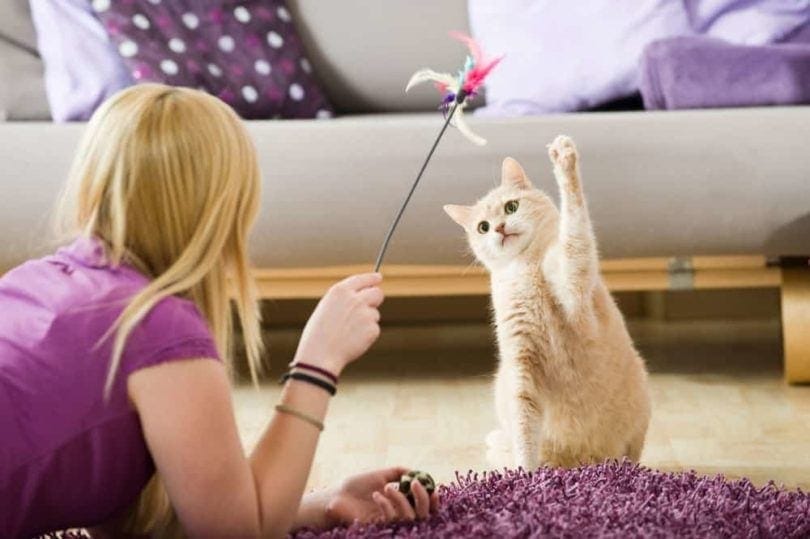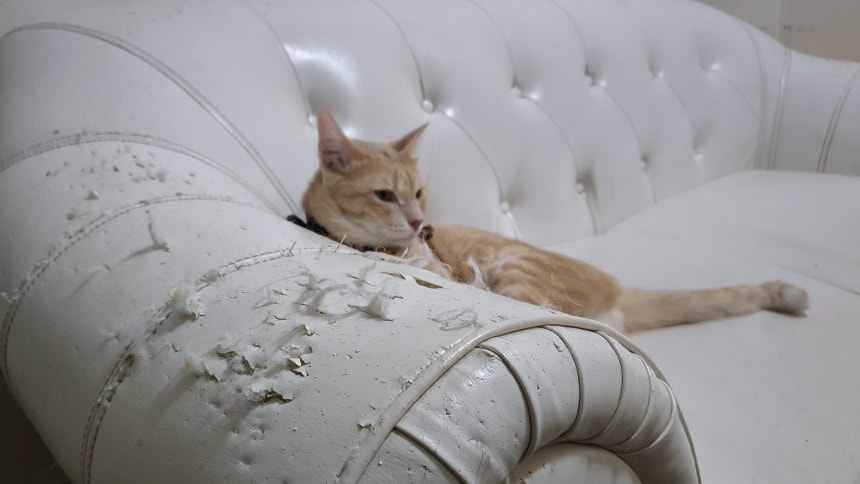
If your cat is turning the sides of your couch into a tattered mess, it’s time to think about getting a scratching post. But what if you present your cat with a brand new, appropriate scratching object and they completely ignore it, continuing instead to destroy your furniture?
In this article, we’ll tell you how to get a cat to use a scratching post in 10 simple steps. We’ll also tell you what not to do to stop inappropriate scratching, no matter how frustrated you may be.
Before You Begin
Even though it means watching your belongings get torn apart, take some time to observe how and what your cat is scratching. Do they prefer a certain type of material? Do they seem to prefer scratching vertical or horizontal surfaces? Is there a pattern to when they like to scratch?
Your observations will help you be more successful in transferring your cat’s clawing habit to a scratching post. The following items may also be useful in your quest:
How to Get a Cat to Use a Scratching Post
1. Pick the Right Scratching Post Material
These first few steps are where all your observations are put to good use. Scratching posts come in all sizes, shapes, and materials. You’ll want to pick one that most closely matches your cat’s current (inappropriate) scratch object.
Some common scratching post materials include carpet, cardboard, wood, and sisal rope. If your cat doesn’t like how the scratching post feels on their claws, they won’t use it. Whether you buy or build a scratching post, it needs to suit your cat’s preferences for the best results.
2. Match Your Cat’s Scratching Style

If your cat likes to reach up high to scratch, make sure you select a post that’s tall enough to accommodate them. If they prefer to stretch out and scratch the carpet, choose a flat scratching surface instead. Or, cover all your bases and buy a cat tree with both options.
Cat trees often come with multiple scratching materials as well, which is helpful if you haven’t yet figured out what your cat prefers.
3. Location, Location, Location
Position the new scratching post in a location that makes sense to your cat. Sometimes that means placing it right next to the couch or door frame your cat has been shredding.
Other cats like to scratch when they wake up or after eating. For those cats, park the scratching post near their food bowl or favorite nap spot.
Some kitties may enjoy a location near a window where they can get worked up watching wildlife and direct their energies into a good scratch.
4. Make Sure the Post Is Sturdy Material

A wobbly scratching post is of no use to your cat. Not only will it be unlikely to hold up to the vigorous scratching they prefer, but it may also scare them off altogether if it falls.
If you have large breed cats like Maine Coons, opt for a bigger and heavier scratching post that can handle their heft.
For all cats, ensure their new scratcher is stable and secure, anchoring it as needed. This precaution will also help keep any human kids in the house safe from pulling the post over onto themselves.
5 . Use Catnip
To entice your cat to use the scratching post, try sprinkling catnip on or near it. Cats that enjoy the scent or taste of the herb may show more interest in the spiked scratching post. Of course, this won’t work if your cat is one of those that isn’t attracted to catnip.
6. Use Toys

Another option to attract your cat to the scratching post is to use a favorite toy, such as a teaser wand or laser pointer. Direct the laser or dangle the wand onto the scratching surface, allowing the cat to grab it and sink their claws into the post simultaneously.
This method also serves as its training reward, as your cat gets to enjoy playtime while learning to use their new scratching post.
7. Try a Pheromone Spray
Another option to attract your cat to the scratching post is to apply a cat pheromone spray, such as Feliway. These products are designed to mimic the natural scents of a cat. Because one reason cats scratch is to mark their territory, applying the smell of “another cat” to the post can motivate them to leave their calling card.
8. Avoid Territorial Clashes

If you have more than one cat, don’t risk causing a power struggle over a new scratching post.
Cats that don’t get along may battle (sometimes literally) over control of the post. The loser will probably resort back to scratching whatever surface you were trying to save, defeating the purpose of buying the scratcher in the first place.
Avoid a territorial clash by buying enough scratching surfaces for all cats to stake their claim. Your bank account may hate you, but you’ll save your couches and, hopefully, avoid other unpleasant stressed cat behaviors, like urine marking.
9. Reward Your Cat
In the early stages of teaching your cat to use a scratching post, be generous about rewarding good behavior. Keep a container of treats or other favorite food handy to reward your cat when you catch them scratching the post instead of the couch.
Positive reinforcement is generally the most effective training method for cats, although it requires patience and good timing on your part.
10. Protect Your Belongings and Discourage Scratching

Because it can take some time to redirect your cat’s scratching to a post, you may need to take additional precautions to protect your furniture and discourage scratching. One option is to cover surfaces in a material that doesn’t feel good to a cat’s claws, such as aluminum foil. You can also use something sticky like double-sided tape.
Scratching is a normal cat behavior, but that doesn't mean you have to sacrifice your belongings! The right pair of nail clippers can help you keep your cat's nails perfectly trimmed. We recommend Hepper's Cat Nail Clipper Set, which includes two different sizes of stainless steel clippers, a built-in nail file, and a convenient storage pouch. You'll love the comfortable handles, precision blades, and protective safety guard.
At Pet Keen, we've admired Hepper for many years, and decided to take a controlling ownership interest so that we could benefit from the outstanding designs of this cool cat company!
What to Avoid While Scratch Training Your Cat
No matter how annoyed you get at your cat’s inappropriate scratching, avoid the temptation to resort to negative training methods. These include punishing your cat or using loud noises or spray bottles to scare your cat away from scratching.
Punishment doesn’t tend to work as well as the other steps we listed. They can also have unintended results, such as harming the bond between you and your cat. Your cat could also become anxious and develop new, unpleasant behaviors such as house soiling or hiding constantly.
In Conclusion
Inappropriate scratching can be both frustrating and expensive to deal with. While scratching is an instinctive behavior for cats, it can be redirected in a way that’s satisfactory for both you and your feline friend. These 10 steps give you plenty of options for training your cat. However, if your cat doesn’t seem to be getting the message, consult your veterinarian about alternatives, including a referral to a feline behavior specialist if necessary.
Featured Image Credit: Frisco 21, Chewy








